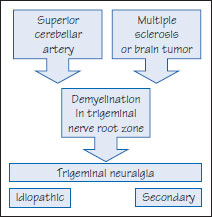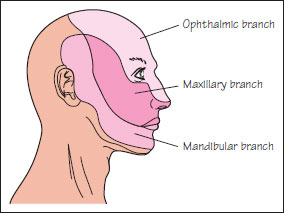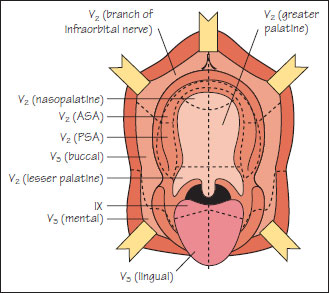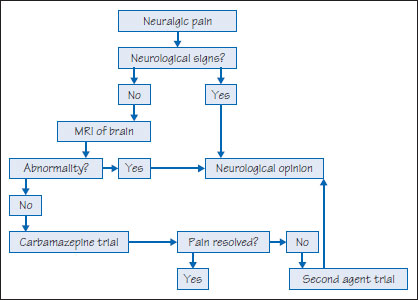50 Neurological conditions and pain: Trigeminal neuralgia
Figure 50.1 Causes of trigeminal neuralgia.

Figure 50.2a Trigeminal dermatomes.

Figure 50.2b Intraoral innervations. ASA, anterior superior alveolar; PSA, posterior superior alveolar.

Figure 50.3 Management of neuralgia.

Pain of a neurological origin in the trigeminal area is termed trigeminal neuralgia (TN). The cause may be clear, when it is termed secondary TN, but usually no cause is evident; it is then idiopathic (ITN) or simply TN (Figure 50.1).
Trigeminal neuralgia
This includes idiopathic or benign paroxysmal trigeminal neuralgia, tic douloureux, prosopalgia.
Definition: Recurrent attacks of lancinating pain in the distribution of a trigeminal nerve division.
Prevalence (approximate): 1 per 15,000.
Age mainly affected: 50–70 year age group.
Gender mainly affected: F > M.
Etiopathogenesis: Trigeminal neuralgia (TN) appears to result from demyelination causing abnormal nerve signal transmission. In 90–95% of cases, no neurological lesion is identified, and the condition is then labeled ITN. The cause of ITN may be the superior cerebellar artery becoming atherosclerotic and less flexible, pressing on the trigeminal nerve roots in the posterior cranial fossa, damaging the myelin sheath. Demyelination may also be caused by multiple sclerosis (MS), cerebrovascular disease with pontine or medullary infarcts, neoplasms, aneurysms, cysts, trauma, infections, deposits such as amyloidosis or other causes (secondary TN). Some 2% of patients with MS develop TN. Hypertension is increased in patients with TN.
Clinical features
International Headache Society (IHS) defines the characteris/>
Stay updated, free dental videos. Join our Telegram channel

VIDEdental - Online dental courses


